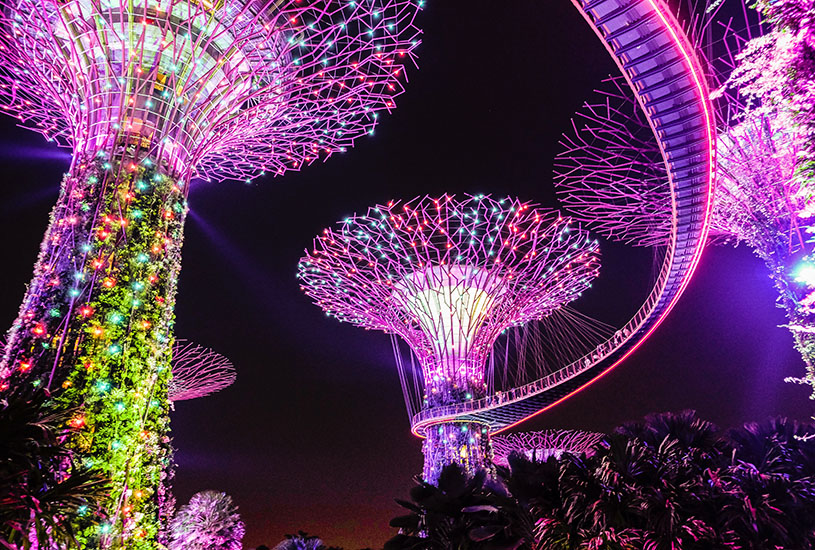Literature is a vessel for reflecting on the world in which we live. In an age of environmental destruction, a new sub-genre has emerged.
Cli-Fi’s optimistic sibling
Solarpunk is the new, optimistic sub-genre of speculative fiction.
It analyses aspects of the current day and predicts where they will lead to in the future.
They often deal with modern anxieties about the world, and how they are expected to worsen over time.
Dr Emily Potter, from Deakin University’s School of Communication and Creative Arts, says that the sub-genre reflects our concerns for the environment.

“Climate change, species extinction, overflowing waste – these are a reality now,” Dr Potter says. “They’re not the futuristic imaginary.”
Many speculative fiction texts envisage a future that is dystopian or post-apocalyptic.
Think of the Morlock-ravaged world in H. G. Wells’ The Time Machine. Or the all-seeing surveillance in George Orwell’s Nineteen Eighty-Four.
Climate Fiction, or cli-fi, is a relative of solarpunk.
As the name suggests, cli-fi stories are about climate change and global warming. Their futures are also dystopian, the characters beyond any hope for change.
But solarpunk speculates how we can deal with these issues.
It takes our current efforts to look after the planet and imagines a world where we have solved all our woes.
In speculative fiction, a reader can test out different incarnations of the world.
What would our lives look like if we had to ration our access to electricity? Or if driverless cars were the normal way to travel?

The genre is so effective because it takes the seed of something from the real world and transforms it, creating a space where we can comment on the current day.
“Speculative fiction offers worlds that are recognisable, but also different enough to trial and test out other ways of thinking, being and doing,” Dr Potter says.
Imagine reading about a world that resembles the one in which we live. Except that climate change had been stabilised, and the Great Barrier Reef was alive and well.
“Solarpunk is about radically revisioning environmental futures with an optimistic tenor,” Dr Potter says. “It wants to think about doing things differently with a remade future in mind.”
The rapid destruction of Earth can feel overwhelming and insurmountable. Stories where we have succeeded in preventing it are important.
By imagining that we can overcome these environmental threats, we can hope to do the same in real life.
What about the ‘punk’ aspect?
But solarpunk stories aren’t about utopias that are devoid of any conflict.
Dr Potter says that the ‘punk’ in solarpunk refers to anti-establishment practices. In these stories, there is a desire for dramatic structural change.

“This form of ‘the punk’ is about unmaking systems not for anarchic purpose, but for more inclusive, democratic, sustainable purposes,” Dr Potter says.
It acknowledges that the world will not simply solve itself. The general population are the ones who band together to create change for the better.
This punk element of the solarpunk sub-genre bears similarities to other utopian movements.
Ecofeminism draws parallels between the mistreatment of the Earth with the oppression of women.
In eco-Afrofuturism, African traditions and black identity are celebrated through an environmental lens.
Movements such as these feed each other. An environmentalist may also be a feminist, or an ally of the LGBTQI+ community.
The politics of each can support the other to affect change.
Sustainable textiles and art nouveau
Aside from activism, solarpunk attitudes can be found in fashion. Some brands are favouring sustainable textiles like wool and linen.
Cotton, which is heavily reliant on water, could be swapped out for hemp. Sheepskin is a less resource-intensive alternative to leather.
Even the colour scheme of solarpunk fashion is dictated by sustainability.

Many synthetic dyes are made from petrochemicals. But plant and animal dyes can be used to create warm tones like red, orange, brown and yellow.
Artistic representations of solarpunk futures are heavily inspired by art nouveau and nature.
Grass is everywhere, and the sunlight catches on the edges of geometric buildings. Everyone has a vegetable garden and a bicycle.
On one level, solarpunk literature encourages a simpler way of life.
It is a world where technology may not appear to play a part. But according to Dr Potter, the sub-genre still celebrates and values technological advancement.

“In some ways, solarpunk continues to invest in the western ideal of technology as a means of human ‘improvement’ – that is, of enhancing the human beyond its innate physical and conceptual limits, and moving it into new, improved modes of being and living in the world,” she says.
The solarpunk movement isn’t about fully returning to a pre-industrial way of being in the world.
Rather, it wants us to be connected to the earth, and recognises that technology can be used to help us achieve it.
One day, technological advancement and the environment may peacefully coexist.



